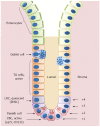Intestinal stem cells and celiac disease
- PMID: 24772248
- PMCID: PMC3999779
- DOI: 10.4252/wjsc.v6.i2.213
Intestinal stem cells and celiac disease
Abstract
Stem cells (SCs) are the key to tissue genesis and regeneration. Given their central role in homeostasis, dysfunctions of the SC compartment play a pivotal role in the development of cancers, degenerative disorders, chronic inflammatory pathologies and organ failure. The gastrointestinal tract is constantly exposed to harsh mechanical and chemical conditions and most of the epithelial cells are replaced every 3 to 5 d. According to the so-called Unitarian hypothesis, this renewal is driven by a common intestinal stem cell (ISC) residing within the crypt base at the origin of the crypt-to-villus hierarchical migratory pattern. Celiac disease (CD) can be defined as a chronic immune-mediated disease that is triggered and maintained by dietary proteins (gluten) in genetically predisposed individuals. Many advances have been achieved over the last years in understanding of the pathogenic interactions among genetic, immunological and environmental factors in CD, with a particular emphasis on intestinal barrier and gut microbiota. Conversely, little is known about ISC modulation and deregulation in active celiac disease and upon a gluten-free diet. Nonetheless, bone marrow-derived SC transplantation has become an option for celiac patients with complicated or refractory disease. This manuscript summarizes the "state of the art" regarding CD and ISCs, their niche and potential role in the development and treatment of the disease.
Keywords: CD133; Celiac disease; Gut barrier; Gut microbiota; Intestinal stem cells; Lgr5; Paneth cells.
Figures



References
-
- Mimeault M, Hauke R, Batra SK. Stem cells: a revolution in therapeutics-recent advances in stem cell biology and their therapeutic applications in regenerative medicine and cancer therapies. Clin Pharmacol Ther. 2007;82:252–264. - PubMed
-
- Piscaglia AC, Di Campli C, Gasbarrini G, Gasbarrini A. Stem cells: new tools in gastroenterology and hepatology. Dig Liver Dis. 2003;35:507–514. - PubMed
-
- Lajtha LG. Stem cell concepts. Differentiation. 1979;14:23–34. - PubMed
-
- Potten CS, Loeffler M. Stem cells: attributes, cycles, spirals, pitfalls and uncertainties. Lessons for and from the crypt. Development. 1990;110:1001–1020. - PubMed
-
- Piscaglia AC, Shupe T, Gasbarrini A, Petersen BE. Microarray RNA/DNA in different stem cell lines. Curr Pharm Biotechnol. 2007;8:167–175. - PubMed
Publication types
LinkOut - more resources
Full Text Sources
Other Literature Sources
Research Materials

